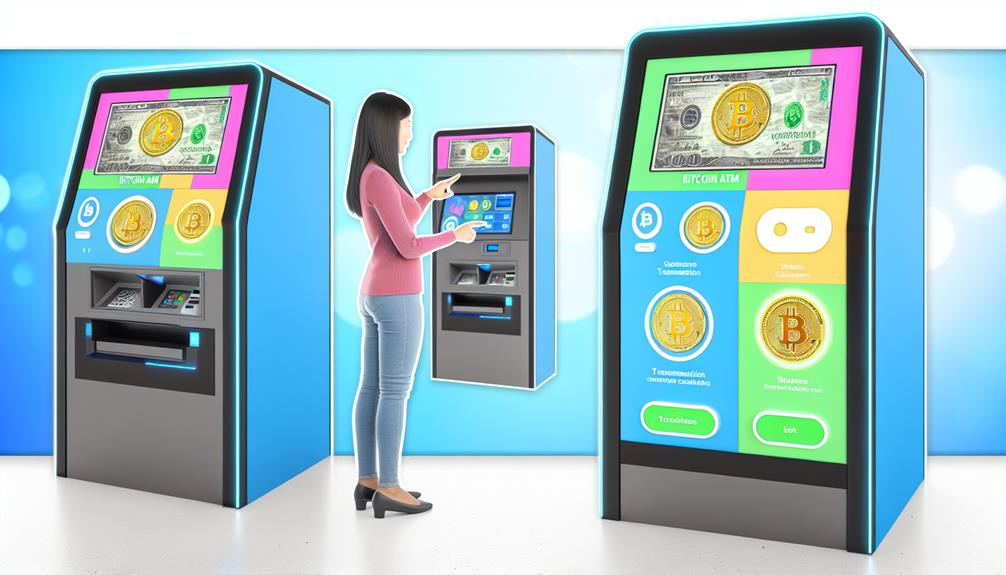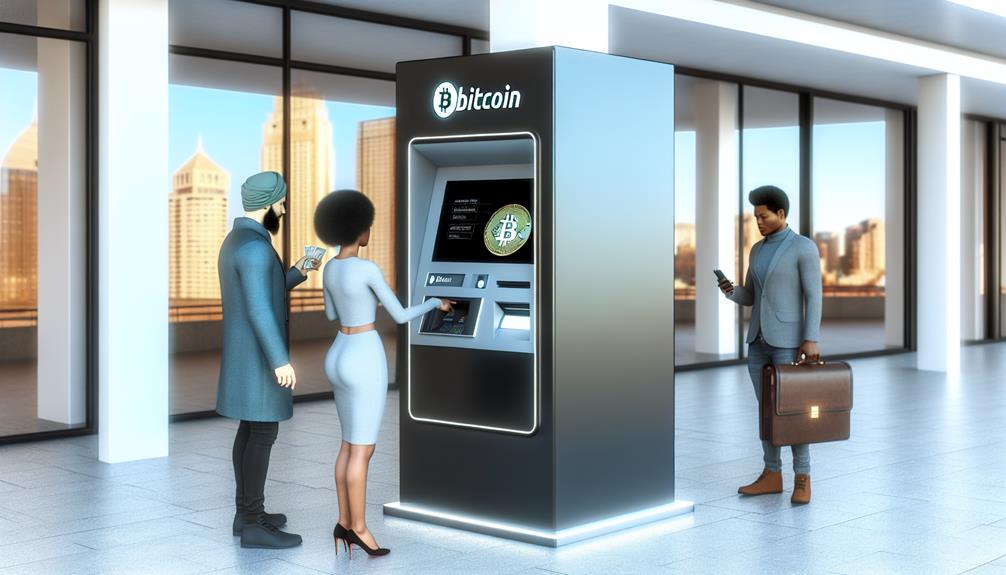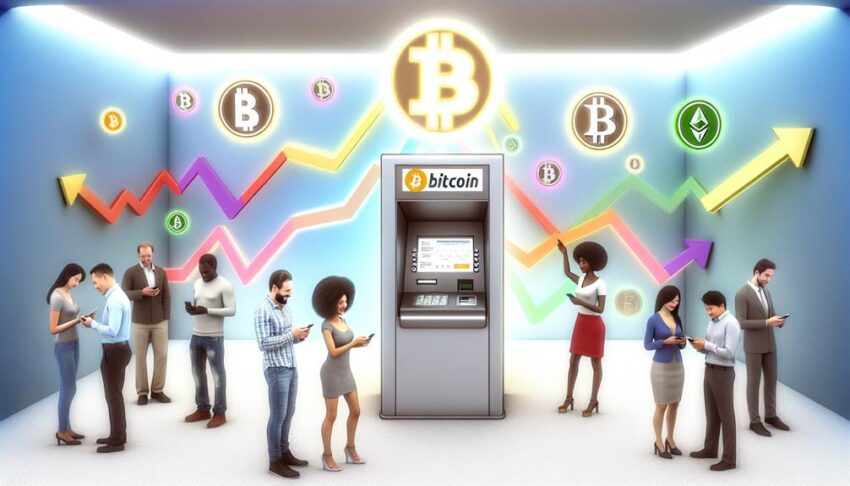When you approach a Bitcoin ATM, you might wonder how this machine can facilitate transactions in the world of cryptocurrency. It's designed to be user-friendly, allowing you to buy or sell Bitcoin with relative ease. However, the process involves several steps, including connecting to the Bitcoin network and verifying transactions against the blockchain. While the convenience is evident, there are nuances and potential drawbacks you should consider. What are the security features that protect your transactions, and how do fees compare to other methods?
Overview of Bitcoin ATMs
How do Bitcoin ATMs fit into the broader landscape of cryptocurrency transactions? These machines serve as vital access points for users wanting to buy or sell Bitcoin and other cryptocurrencies, thereby facilitating greater cryptocurrency adoption. There are several Bitcoin ATM types, including two-way ATMs, which allow both buying and selling, and one-way ATMs, which enable only the purchase of Bitcoin. This diversity caters to different user needs and enhances convenience.
When you approach a Bitcoin ATM, you'll typically find a user-friendly interface that guides you through the transaction process. Most machines require you to scan a QR code from your cryptocurrency wallet, which guarantees the transaction goes directly to your account. In addition to Bitcoin, many ATMs support various altcoins, expanding your options for digital currency transactions.
The presence of Bitcoin ATMs also helps bridge the gap between traditional finance and the decentralized cryptocurrency world. By providing a familiar cash-based transaction method, they attract users who might be hesitant to engage with online exchanges or digital wallets. As a result, Bitcoin ATMs play a significant role in increasing cryptocurrency's mainstream acceptance.
Moreover, the geographical distribution of these ATMs can influence local cryptocurrency markets. Areas with higher concentrations of Bitcoin ATMs often see increased trading volumes and user engagement, further solidifying the importance of these machines in the evolving landscape of digital finance. Through their varied types and accessibility, Bitcoin ATMs are essential to enhancing cryptocurrency adoption globally.
How Transactions Are Processed
When you initiate a transaction at a Bitcoin ATM, the process is designed to be both secure and efficient. First, the ATM connects to the Bitcoin network to facilitate the transaction. This connection guarantees that your transaction is verified against the blockchain, which is vital for preventing double-spending. Once you input the amount of Bitcoin you want to purchase or sell, the ATM calculates the transaction fee, which varies based on the fee structure set by the operator.
Here's a brief overview of the transaction process:
| Step | Description |
|---|---|
| 1. Input Amount | Enter the amount of Bitcoin to buy/sell. |
| 2. Wallet Address | Provide your Bitcoin wallet address. |
| 3. Transaction Fee | ATM calculates the applicable fee. |
| 4. Transaction Verification | The network verifies the transaction against the blockchain. |
| 5. Confirmation | You receive confirmation once verified. |
Understanding the fee structures is important, as these fees can fluctuate based on network congestion and the ATM operator's policies. After the transaction verification is complete, the system broadcasts the transaction to the Bitcoin network, which can take anywhere from several minutes to more, depending on the current load.
User Interface and Experience

A seamless user interface is vital for enhancing the overall experience at Bitcoin ATMs. When you approach one of these machines, the design elements play an important role in facilitating user interaction. A well-crafted interface is intuitive, guiding you through the transaction process with minimal confusion.
The effectiveness of a Bitcoin ATM's user interface can be assessed through several key design elements:
- Clarity: Clear instructions help you understand each step of the transaction, reducing the likelihood of errors.
- Responsiveness: The interface should respond quickly to your inputs, guaranteeing a fluid experience that doesn't leave you waiting unnecessarily.
- Visual Hierarchy: Important actions should be prominently displayed, allowing you to focus on what matters without being overwhelmed by too much information.
- Accessibility: Incorporating features like language options and screen readability guarantees that a wider audience can use the ATM comfortably.
Security Features and Protocols
In the domain of Bitcoin ATMs, security features and protocols play an important role in safeguarding both user transactions and sensitive information. As you engage with these machines, it's vital to understand the mechanisms designed to protect your assets.
One of the primary security measures employed is advanced encryption methods. These methods guarantee that your data, such as wallet addresses and transaction amounts, are securely transmitted and stored. For instance, Bitcoin ATMs typically use SSL (Secure Socket Layer) encryption to create a secure connection between the ATM and the network, preventing unauthorized access.
Fraud prevention is another significant feature integrated into these devices. Many Bitcoin ATMs implement multi-factor authentication (MFA) to verify user identities. This adds an extra layer of security, making it harder for malicious actors to impersonate legitimate users. Additionally, transaction monitoring systems are put in place to detect suspicious activities in real-time, allowing for immediate action if fraud is suspected.
Here's a summary of the key security features:
| Feature | Description | Purpose |
|---|---|---|
| Encryption Methods | SSL encryption for data protection | Safeguards user information |
| Multi-Factor Authentication | Requires multiple forms of verification | Prevents unauthorized access |
| Transaction Monitoring | Real-time analysis of transactions | Detects and prevents fraud |
| User Education | Informing users about best security practices | Enhances overall security awareness |
Understanding these security features can help you use Bitcoin ATMs with greater confidence, knowing that your transactions are protected against potential threats.
Benefits and Limitations

Bitcoin ATMs offer a unique blend of convenience and accessibility for users looking to buy or sell cryptocurrencies. You can quickly convert cash into Bitcoin or vice versa, often without the need for a bank account. However, while these machines present numerous advantages, they also come with certain limitations.
One of the primary benefits is user accessibility. Bitcoin ATMs are typically located in public places, making them easier to reach than traditional exchanges. This accessibility is essential for users who may not have access to online platforms. Additionally, many ATMs allow for anonymous transactions, addressing privacy concerns that some users may have when using conventional financial systems.
However, there are notable limitations to take into account:
- Transaction fees: Bitcoin ATMs often charge higher fees than online exchanges, which can cut into your profits when buying or selling cryptocurrencies.
- Market volatility: The prices displayed on ATMs can fluctuate rapidly, reflecting market changes. This means you might not get the best rate available at the moment.
- Limited availability: Not all areas have Bitcoin ATMs, which can restrict access for some users.
- Technical issues: Like any technology, ATMs can experience downtime, leading to potential inconveniences when you want to make a transaction.
Frequently Asked Questions
Are Bitcoin ATMS Available in Every Country?
Bitcoin ATMs aren't available in every country due to varying global availability and differing country regulations. Some nations embrace cryptocurrency, while others impose restrictions, affecting the presence and accessibility of these machines in specific regions.
Can I Withdraw Cash From a Bitcoin Atm?
Yes, you can withdraw cash from a Bitcoin ATM. The Bitcoin withdrawal process involves selecting cash availability options, entering your wallet information, and confirming the transaction, which typically results in immediate cash dispensed.
What Are the Fees Associated With Using Bitcoin Atms?
When you're exploring the world of Bitcoin ATMs, you'll find that transaction costs can vary considerably. Typically, these fees can enhance your user experience, making your crypto journey smoother, albeit sometimes pricier than expected.
Do Bitcoin ATMS Require Identification for Transactions?
Yes, Bitcoin ATMs often require user authentication, especially for larger transactions. This helps guarantee security and compliance with regulations. Additionally, there may be transaction limits based on the identification provided during the process.
How Often Are Bitcoin ATM Rates Updated?
Did you know Bitcoin's price can fluctuate by thousands in a day? Bitcoin ATM rates are updated frequently, often every few minutes, to reflect these changes, making ATM rate comparison essential for savvy users.
Conclusion
To summarize, Bitcoin ATMs serve as gateways to the crypto world, blending convenience and technology. They process transactions like a well-oiled machine, connecting users to the blockchain in real-time. While they offer a level of anonymity, the fees can feel like a toll on your digital journey. Understanding their workings can empower you to navigate this landscape more effectively, ensuring your experience is not just a transaction, but a step into the future of finance.
